Attached files
| file | filename |
|---|---|
| 8-K - IDAHO POWER CO | a8-kmay262011.htm |
may262011slide
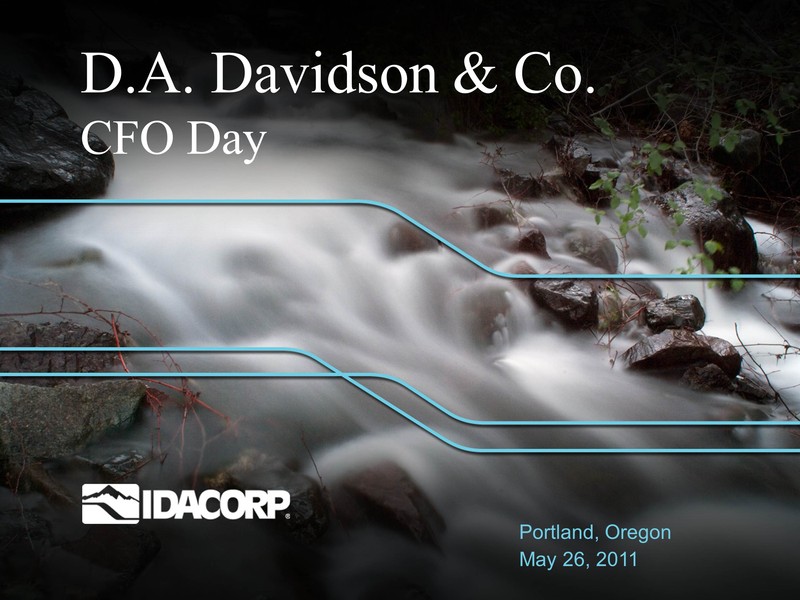
D.A. Davidson & Co. CFO Day
Portland, Oregon May 26, 2011
Portland, Oregon May 26, 2011
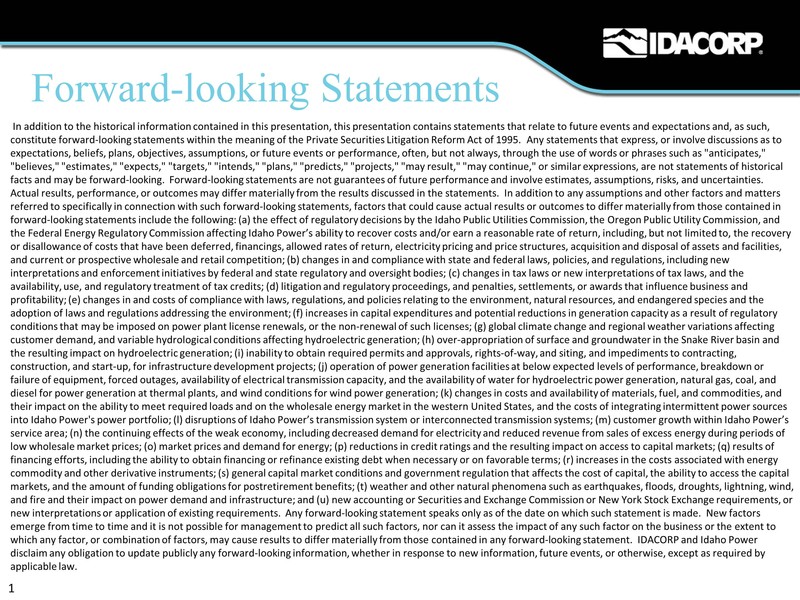
Forward-looking Statements
1
In addition to the historical information contained in this presentation, this presentation contains statements that relate to future events and expectations and, as such, constitute forward-looking statements within the meaning of the Private Securities Litigation Reform Act of 1995. Any statements that express, or involve discussions as to expectations, beliefs, plans, objectives, assumptions, or future events or performance, often, but not always, through the use of words or phrases such as "anticipates," "believes," "estimates," "expects," "targets," "intends," "plans," "predicts," "projects," "may result," "may continue," or similar expressions, are not statements of historical facts and may be forward-looking. Forward-looking statements are not guarantees of future performance and involve estimates, assumptions, risks, and uncertainties. Actual results, performance, or outcomes may differ materially from the results discussed in the statements. In addition to any assumptions and other factors and matters referred to specifically in connection with such forward-looking statements, factors that could cause actual results or outcomes to differ materially from those contained in forward-looking statements include the following: (a) the effect of regulatory decisions by the Idaho Public Utilities Commission, the Oregon Public Utility Commission, and the Federal Energy Regulatory Commission affecting Idaho Power’s ability to recover costs and/or earn a reasonable rate of return, including, but not limited to, the recovery or disallowance of costs that have been deferred, financings, allowed rates of return, electricity pricing and price structures, acquisition and disposal of assets and facilities, and current or prospective wholesale and retail competition; (b) changes in and compliance with state and federal laws, policies, and regulations, including new interpretations and enforcement initiatives by federal and state regulatory and oversight bodies; (c) changes in tax laws or new interpretations of tax laws, and the availability, use, and regulatory treatment of tax credits; (d) litigation and regulatory proceedings, and penalties, settlements, or awards that influence business and profitability; (e) changes in and costs of compliance with laws, regulations, and policies relating to the environment, natural resources, and endangered species and the adoption of laws and regulations addressing the environment; (f) increases in capital expenditures and potential reductions in generation capacity as a result of regulatory conditions that may be imposed on power plant license renewals, or the non-renewal of such licenses; (g) global climate change and regional weather variations affecting customer demand, and variable hydrological conditions affecting hydroelectric generation; (h) over-appropriation of surface and groundwater in the Snake River basin and the resulting impact on hydroelectric generation; (i) inability to obtain required permits and approvals, rights-of-way, and siting, and impediments to contracting, construction, and start-up, for infrastructure development projects; (j) operation of power generation facilities at below expected levels of performance, breakdown or failure of equipment, forced outages, availability of electrical transmission capacity, and the availability of water for hydroelectric power generation, natural gas, coal, and diesel for power generation at thermal plants, and wind conditions for wind power generation; (k) changes in costs and availability of materials, fuel, and commodities, and their impact on the ability to meet required loads and on the wholesale energy market in the western United States, and the costs of integrating intermittent power sources into Idaho Power's power portfolio; (l) disruptions of Idaho Power’s transmission system or interconnected transmission systems; (m) customer growth within Idaho Power’s service area; (n) the continuing effects of the weak economy, including decreased demand for electricity and reduced revenue from sales of excess energy during periods of low wholesale market prices; (o) market prices and demand for energy; (p) reductions in credit ratings and the resulting impact on access to capital markets; (q) results of financing efforts, including the ability to obtain financing or refinance existing debt when necessary or on favorable terms; (r) increases in the costs associated with energy commodity and other derivative instruments; (s) general capital market conditions and government regulation that affects the cost of capital, the ability to access the capital markets, and the amount of funding obligations for postretirement benefits; (t) weather and other natural phenomena such as earthquakes, floods, droughts, lightning, wind, and fire and their impact on power demand and infrastructure; and (u) new accounting or Securities and Exchange Commission or New York Stock Exchange requirements, or new interpretations or application of existing requirements. Any forward-looking statement speaks only as of the date on which such statement is made. New factors emerge from time to time and it is not possible for management to predict all such factors, nor can it assess the impact of any such factor on the business or the extent to which any factor, or combination of factors, may cause results to differ materially from those contained in any forward-looking statement. IDACORP and Idaho Power disclaim any obligation to update publicly any forward-looking information, whether in response to new information, future events, or otherwise, except as required by applicable law.
1
In addition to the historical information contained in this presentation, this presentation contains statements that relate to future events and expectations and, as such, constitute forward-looking statements within the meaning of the Private Securities Litigation Reform Act of 1995. Any statements that express, or involve discussions as to expectations, beliefs, plans, objectives, assumptions, or future events or performance, often, but not always, through the use of words or phrases such as "anticipates," "believes," "estimates," "expects," "targets," "intends," "plans," "predicts," "projects," "may result," "may continue," or similar expressions, are not statements of historical facts and may be forward-looking. Forward-looking statements are not guarantees of future performance and involve estimates, assumptions, risks, and uncertainties. Actual results, performance, or outcomes may differ materially from the results discussed in the statements. In addition to any assumptions and other factors and matters referred to specifically in connection with such forward-looking statements, factors that could cause actual results or outcomes to differ materially from those contained in forward-looking statements include the following: (a) the effect of regulatory decisions by the Idaho Public Utilities Commission, the Oregon Public Utility Commission, and the Federal Energy Regulatory Commission affecting Idaho Power’s ability to recover costs and/or earn a reasonable rate of return, including, but not limited to, the recovery or disallowance of costs that have been deferred, financings, allowed rates of return, electricity pricing and price structures, acquisition and disposal of assets and facilities, and current or prospective wholesale and retail competition; (b) changes in and compliance with state and federal laws, policies, and regulations, including new interpretations and enforcement initiatives by federal and state regulatory and oversight bodies; (c) changes in tax laws or new interpretations of tax laws, and the availability, use, and regulatory treatment of tax credits; (d) litigation and regulatory proceedings, and penalties, settlements, or awards that influence business and profitability; (e) changes in and costs of compliance with laws, regulations, and policies relating to the environment, natural resources, and endangered species and the adoption of laws and regulations addressing the environment; (f) increases in capital expenditures and potential reductions in generation capacity as a result of regulatory conditions that may be imposed on power plant license renewals, or the non-renewal of such licenses; (g) global climate change and regional weather variations affecting customer demand, and variable hydrological conditions affecting hydroelectric generation; (h) over-appropriation of surface and groundwater in the Snake River basin and the resulting impact on hydroelectric generation; (i) inability to obtain required permits and approvals, rights-of-way, and siting, and impediments to contracting, construction, and start-up, for infrastructure development projects; (j) operation of power generation facilities at below expected levels of performance, breakdown or failure of equipment, forced outages, availability of electrical transmission capacity, and the availability of water for hydroelectric power generation, natural gas, coal, and diesel for power generation at thermal plants, and wind conditions for wind power generation; (k) changes in costs and availability of materials, fuel, and commodities, and their impact on the ability to meet required loads and on the wholesale energy market in the western United States, and the costs of integrating intermittent power sources into Idaho Power's power portfolio; (l) disruptions of Idaho Power’s transmission system or interconnected transmission systems; (m) customer growth within Idaho Power’s service area; (n) the continuing effects of the weak economy, including decreased demand for electricity and reduced revenue from sales of excess energy during periods of low wholesale market prices; (o) market prices and demand for energy; (p) reductions in credit ratings and the resulting impact on access to capital markets; (q) results of financing efforts, including the ability to obtain financing or refinance existing debt when necessary or on favorable terms; (r) increases in the costs associated with energy commodity and other derivative instruments; (s) general capital market conditions and government regulation that affects the cost of capital, the ability to access the capital markets, and the amount of funding obligations for postretirement benefits; (t) weather and other natural phenomena such as earthquakes, floods, droughts, lightning, wind, and fire and their impact on power demand and infrastructure; and (u) new accounting or Securities and Exchange Commission or New York Stock Exchange requirements, or new interpretations or application of existing requirements. Any forward-looking statement speaks only as of the date on which such statement is made. New factors emerge from time to time and it is not possible for management to predict all such factors, nor can it assess the impact of any such factor on the business or the extent to which any factor, or combination of factors, may cause results to differ materially from those contained in any forward-looking statement. IDACORP and Idaho Power disclaim any obligation to update publicly any forward-looking information, whether in response to new information, future events, or otherwise, except as required by applicable law.

Who We Are
Our Mission: Prosper by providing reliable, responsible, fair-priced energy services, today and tomorrow.
Our Vision: To be regarded as an exceptional utility.
2
Our Mission: Prosper by providing reliable, responsible, fair-priced energy services, today and tomorrow.
Our Vision: To be regarded as an exceptional utility.
2
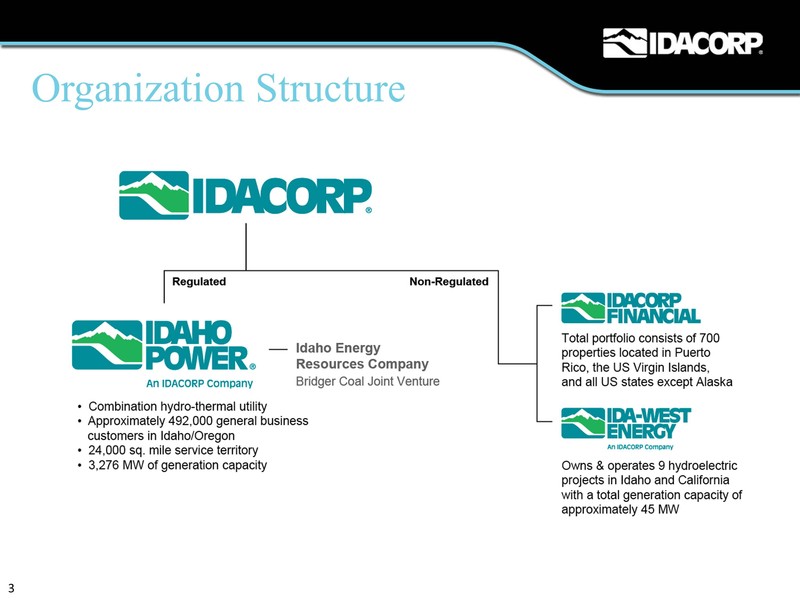
Organization Structure
3
3
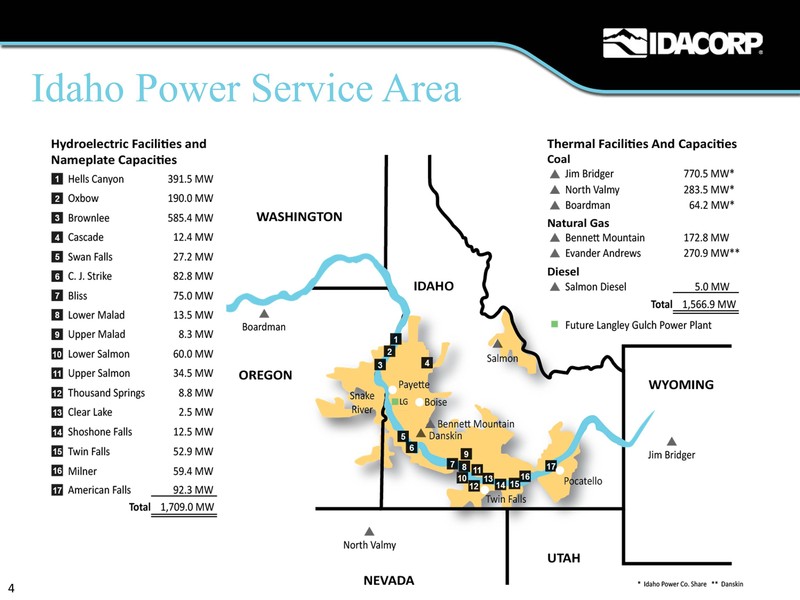
Idaho Power Service Area
4
4
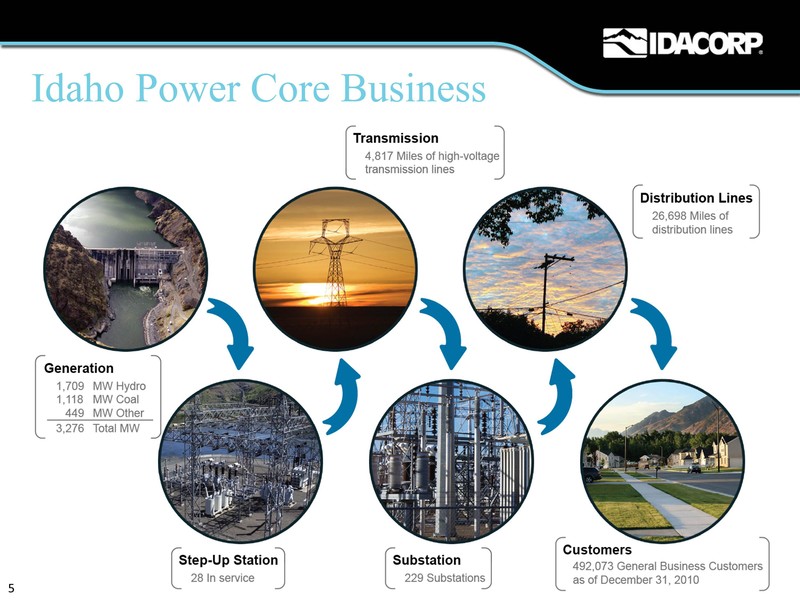
Idaho Power Core Business
5
5
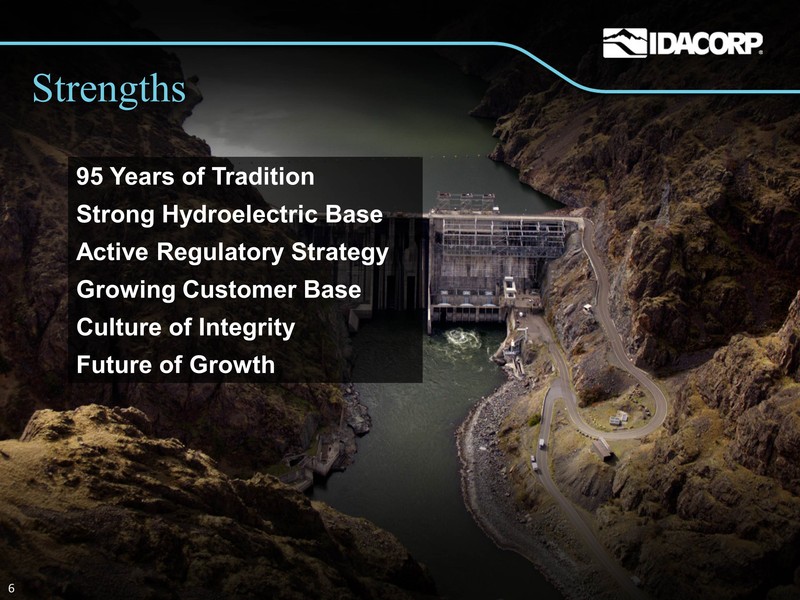
Strengths
Strong Hydroelectric Base
95 Years of Tradition
Growing Customer Base
Culture of Integrity
Active Regulatory Strategy
Future of Growth
6
Strong Hydroelectric Base
95 Years of Tradition
Growing Customer Base
Culture of Integrity
Active Regulatory Strategy
Future of Growth
6
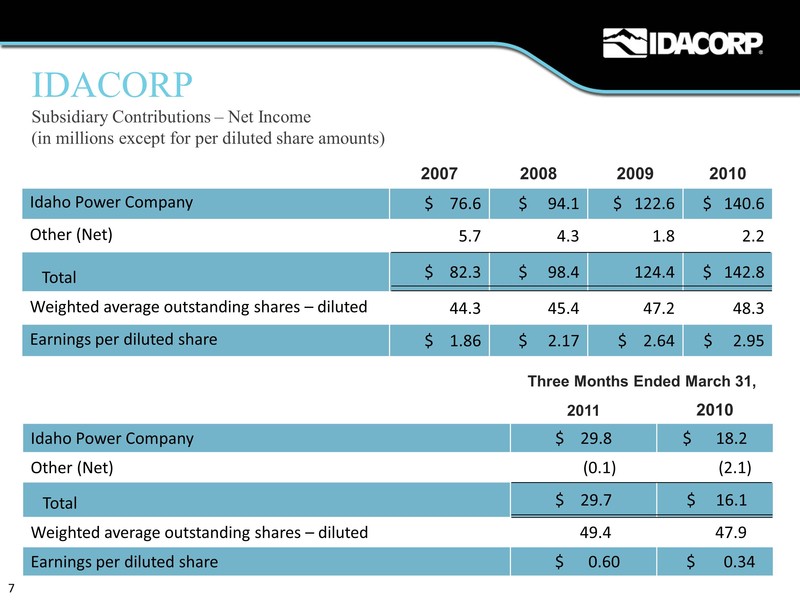
IDACORP Subsidiary Contributions – Net Income (in millions except for per diluted share amounts)
7
7
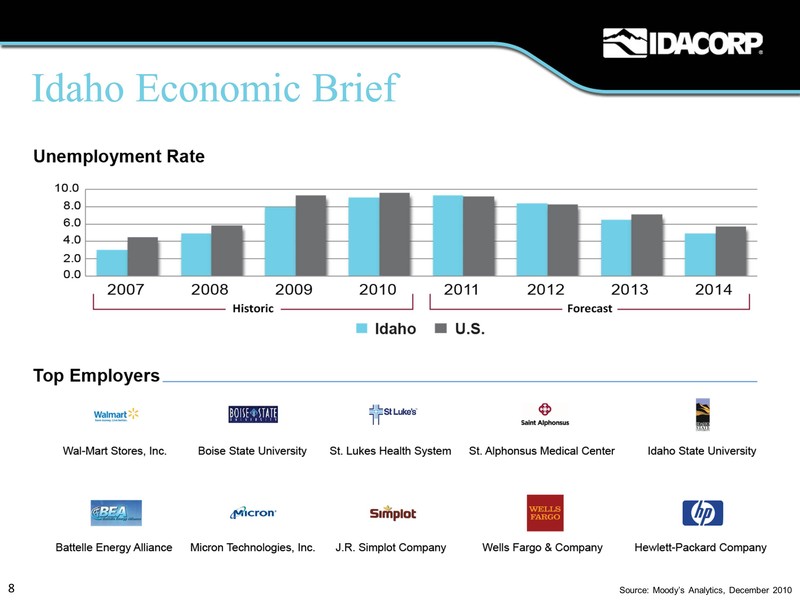
Idaho Economic Brief
8
Idaho Economic Brief
Source: Moody’s Analytics, December 2010
8
Idaho Economic Brief
Source: Moody’s Analytics, December 2010
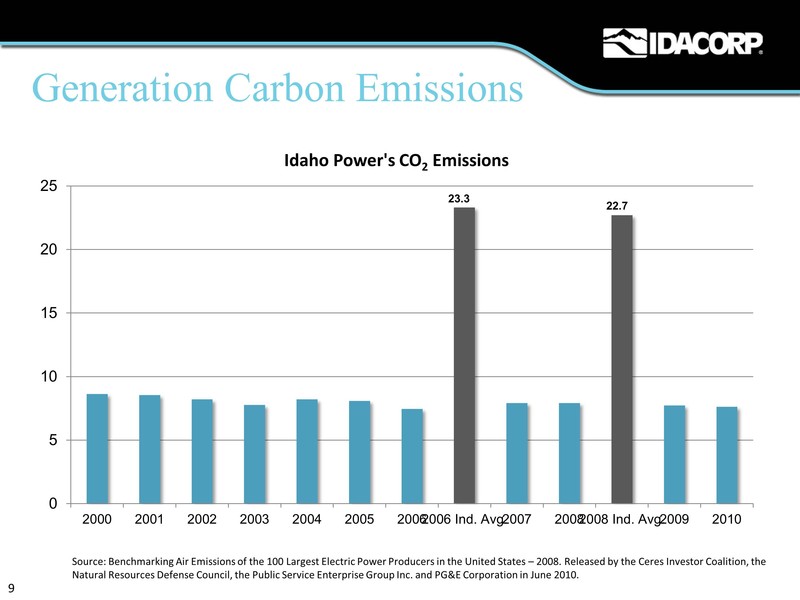
Generation Carbon Emissions
Source: Benchmarking Air Emissions of the 100 Largest Electric Power Producers in the United States – 2008. Released by the Ceres Investor Coalition, the Natural Resources Defense Council, the Public Service Enterprise Group Inc. and PG&E Corporation in June 2010.
9
Idaho Power's CO2 Emissions
23.3
22.7
Source: Benchmarking Air Emissions of the 100 Largest Electric Power Producers in the United States – 2008. Released by the Ceres Investor Coalition, the Natural Resources Defense Council, the Public Service Enterprise Group Inc. and PG&E Corporation in June 2010.
9
Idaho Power's CO2 Emissions
23.3
22.7
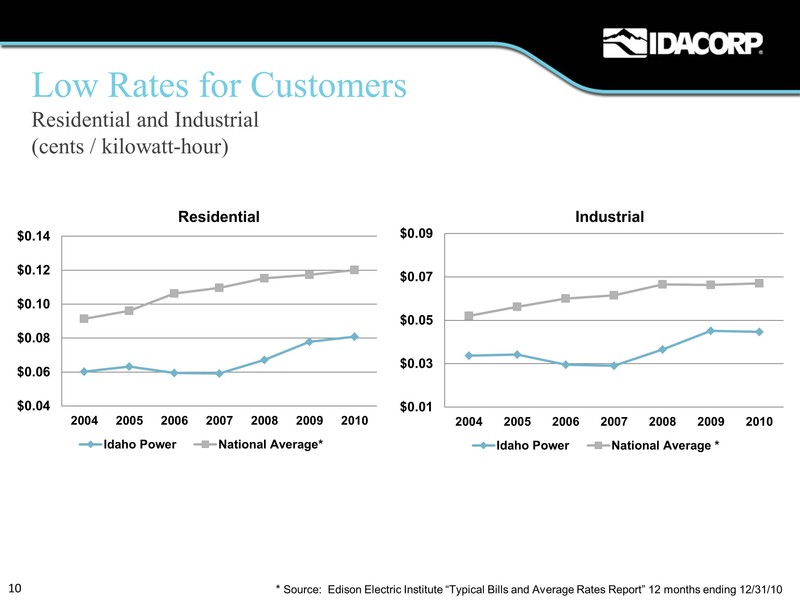
Low Rates for Customers Residential and Industrial (cents / kilowatt-hour)
10
* Source: Edison Electric Institute “Typical Bills and Average Rates Report” 12 months ending 12/31/10
Residential
Industrial
10
* Source: Edison Electric Institute “Typical Bills and Average Rates Report” 12 months ending 12/31/10
Residential
Industrial
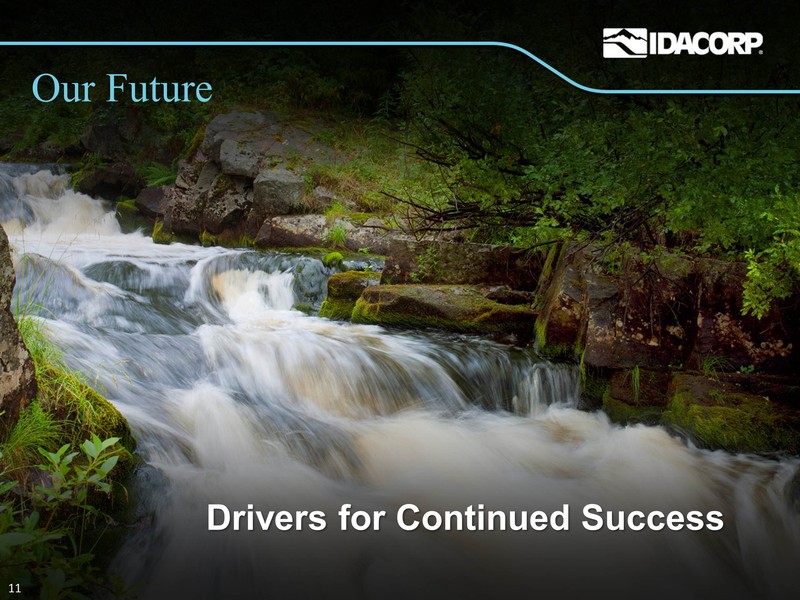
Our Future
Drivers for Continued Success
11
Drivers for Continued Success
11
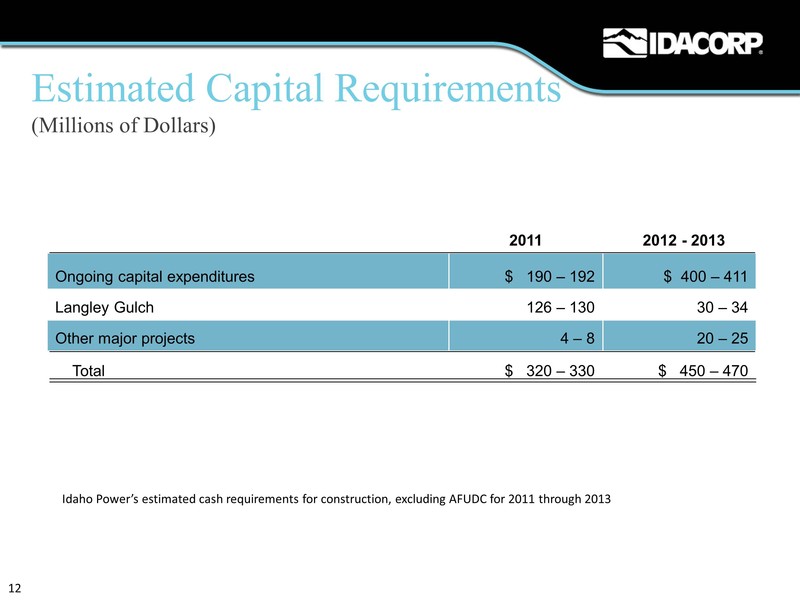
Estimated Capital Requirements (Millions of Dollars)
12
Idaho Power’s estimated cash requirements for construction, excluding AFUDC for 2011 through 2013
12
Idaho Power’s estimated cash requirements for construction, excluding AFUDC for 2011 through 2013
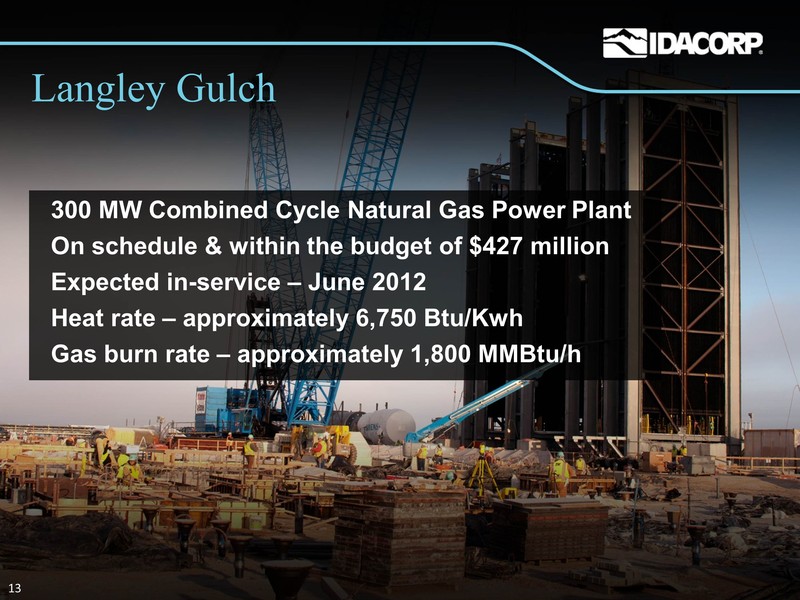
Langley Gulch
13
300 MW Combined Cycle Natural Gas Power Plant On schedule & within the budget of $427 million Expected in-service – June 2012 Heat rate – approximately 6,750 Btu/Kwh Gas burn rate – approximately 1,800 MMBtu/h
13
300 MW Combined Cycle Natural Gas Power Plant On schedule & within the budget of $427 million Expected in-service – June 2012 Heat rate – approximately 6,750 Btu/Kwh Gas burn rate – approximately 1,800 MMBtu/h
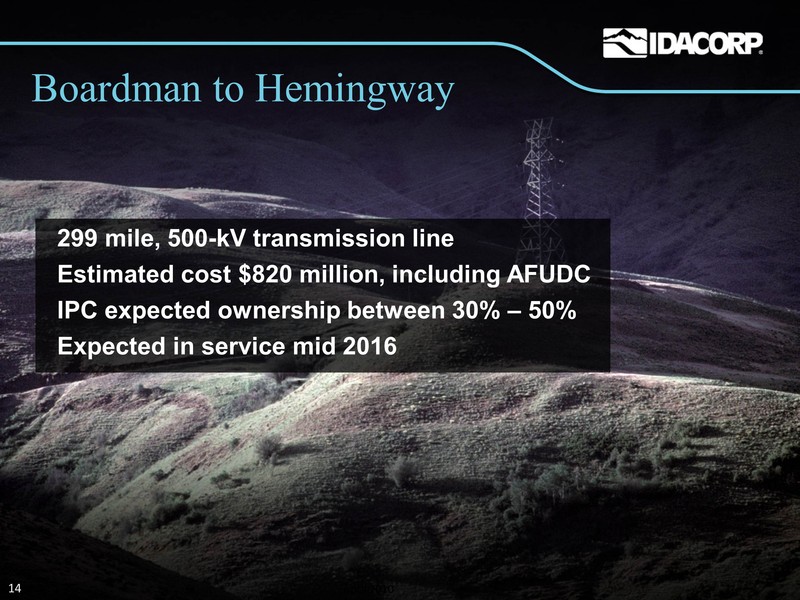
April 2010
Boardman to Hemingway
299 mile, 500-kV transmission line Estimated cost $820 million, including AFUDC IPC expected ownership between 30% – 50% Expected in service mid 2016
14
Boardman to Hemingway
299 mile, 500-kV transmission line Estimated cost $820 million, including AFUDC IPC expected ownership between 30% – 50% Expected in service mid 2016
14
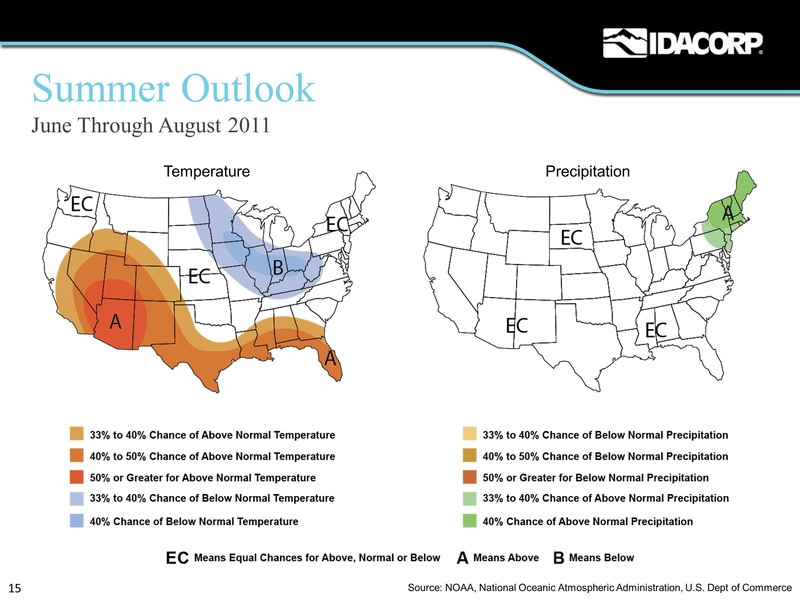
Summer Outlook June Through August 2011
15
Precipitation
Temperature
Source: NOAA, National Oceanic Atmospheric Administration, U.S. Dept of Commerce
15
Precipitation
Temperature
Source: NOAA, National Oceanic Atmospheric Administration, U.S. Dept of Commerce
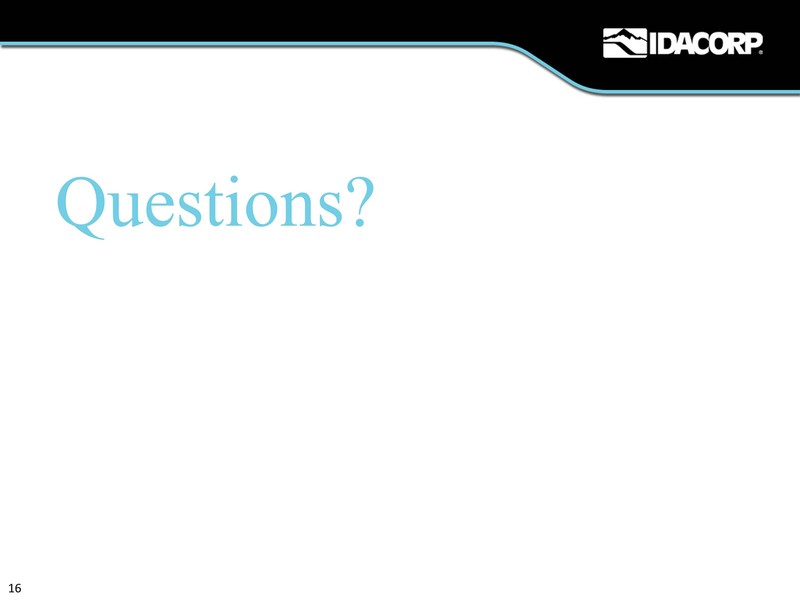
Questions?
16
16
